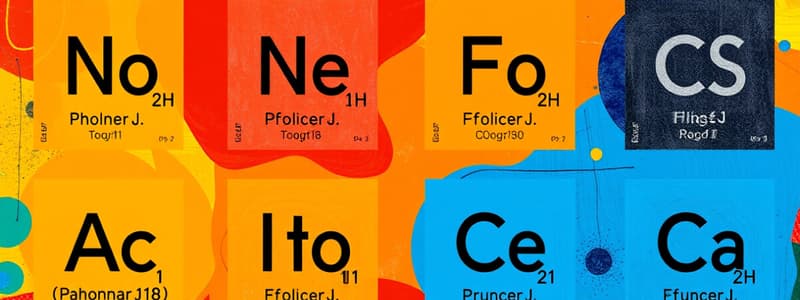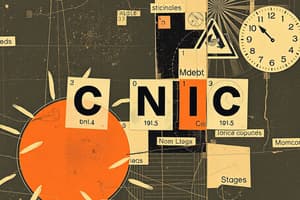Podcast
Questions and Answers
What does nomenclature mean?
What does nomenclature mean?
naming system
What is the procedure for naming ionic compounds?
What is the procedure for naming ionic compounds?
Name the cation; if the charge on the cation can vary, write the charge in parentheses as a Roman numeral; drop the last syllable of the anion and replace it with '-ide' or name the polyatomic ion without changing the last syllable.
What does a compound's charge always have to be?
What does a compound's charge always have to be?
0
What do the Roman numerals represent in ionic compounds?
What do the Roman numerals represent in ionic compounds?
How do you make sure the compounds are balanced?
How do you make sure the compounds are balanced?
In which order are ionic compounds with transition and post-transition metals always written?
In which order are ionic compounds with transition and post-transition metals always written?
What is true about all elements in group 1?
What is true about all elements in group 1?
What is true about all elements in group 2?
What is true about all elements in group 2?
What is true about aluminum?
What is true about aluminum?
What is true about silver?
What is true about silver?
What is true about cadmium and zinc?
What is true about cadmium and zinc?
What is true about all elements in group 17?
What is true about all elements in group 17?
What is true about sulfur, oxygen, and selenium?
What is true about sulfur, oxygen, and selenium?
What is true about nitrogen and phosphorus?
What is true about nitrogen and phosphorus?
Summarize the cation exceptions to the Roman numerals.
Summarize the cation exceptions to the Roman numerals.
Match the following prefixes for covalent/molecular compounds:
Match the following prefixes for covalent/molecular compounds:
How are simple cations named?
How are simple cations named?
How are simple anions named?
How are simple anions named?
How do you figure out the charge of a monatomic anion?
How do you figure out the charge of a monatomic anion?
What is hydride?
What is hydride?
What is the hydrogen ion?
What is the hydrogen ion?
What are ionic compounds?
What are ionic compounds?
When writing formulas for ionic compounds, how does one denote the amount of each atom contained in the compound?
When writing formulas for ionic compounds, how does one denote the amount of each atom contained in the compound?
What to remember about ionic compounds?
What to remember about ionic compounds?
Review: how does one name an ionic compound?
Review: how does one name an ionic compound?
What is a polyatomic ion?
What is a polyatomic ion?
Flashcards are hidden until you start studying
Study Notes
Nomenclature Overview
- Nomenclature refers to the system of naming compounds in chemistry.
Naming Ionic Compounds
- Name the cation first; if the cation's charge varies, use Roman numerals to indicate the charge.
- For anions, change the suffix to "-ide" unless it's a polyatomic ion; in that case, just use its name.
- Example: MgCl₂ is named magnesium chloride, while FeCO₃ is iron (II) carbonate.
Charge of Compounds
- Compounds must have an overall charge of zero; charges must balance.
Roman Numerals in Ionic Compounds
- Roman numerals indicate the charge of the cation (metal); essential for metals with variable charges.
Balancing Compounds
- Use the criss-cross method to ensure charge balance: the charge (disregarding the sign) of one ion becomes the subscript of the other.
Order of Written Ionic Compounds
- In ionic compounds, the metal (cation) is always listed first, followed by the anion.
Element Charges
- Group 1 elements form ions with a +1 charge.
- Group 2 elements form ions with a +2 charge.
- Aluminum always forms a +3 charge.
- Silver always forms a +1 charge.
- Cadmium and zinc consistently form +2 ions.
- Group 17 elements generate ions with a -1 charge.
- Sulfur, oxygen, and selenium form ions with a -2 charge.
- Nitrogen and phosphorus form ions with a -3 charge.
Exceptions to Roman Numerals
- Silver (Ag⁺) and zinc (Zn²⁺) always have fixed charges and do not need Roman numerals.
- Cadmium (Cd²⁺) also has a fixed charge.
- Tin (Sn) can have Sn²⁺ or Sn⁴⁺, and lead (Pb) can be Pb²⁺ or Pb⁴⁺, requiring Roman numerals.
Covalent/Molecular Compound Prefixes
- Mono- (1), Di- (2), Tri- (3), Tetra- (4), Penta- (5), Hexa- (6), Hepta- (7), Octa- (8), Nona- (9), Deca- (10).
Naming Cations and Anions
- Simple cations are named by stating the element plus "ion" (e.g., Na⁺ is sodium ion).
- Simple anions drop the suffix and add "ide" (e.g., F⁻ is fluoride).
Charge of Monatomic Anions
- The charge equals the group number minus 18.
Special Ions
- Hydride (H⁻) is formed only when reacting with metals.
- The hydrogen ion is represented as H⁺.
Ionic Compounds
- Formed from a cation and an anion, commonly referred to as "salts."
- Binary ionic compounds contain only two elements.
Writing Formulas for Ionic Compounds
- Subscripts indicate the number of each atom present in the compound.
Key Aspects of Ionic Compounds
- Despite ion charges, ionic compounds must be neutral.
- The combined charges of the cation and anion should total zero.
Naming Ionic Compounds Summary
- The metal's name comes first, followed by the nonmetal’s ion name.
- Example: NaCl is named sodium chloride; CaCl₂ is calcium chloride.
Polyatomic Ions
- Comprise two or more different atoms.
Studying That Suits You
Use AI to generate personalized quizzes and flashcards to suit your learning preferences.




